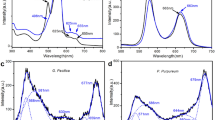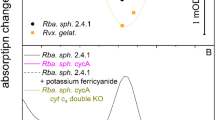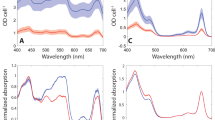Abstract
WHEN Halobacterium halobium is grown at low oxygen concentrations in the light, it synthesises patches of membrane containing a purple pigment. If exposed to low salt concentrations, the cell membrane dissociates into fragments which differ in their protein and pigment composition and can be separated1. The most conspicuous of these fragments is the so-called ‘purple membrane’2. The isolated purple membrane contains 25% lipid and 75% protein2; only a single species of protein has been found. This protein, bacteriorhodopsin, is apparently similar to the animal visual pigment; it contains 1 mol of retinal per mol protein bound as a Schiff base to a lysine residue3. The protein forms a planar lattice in the membrane4 and shows a broad absorption maximum at 570 nm3,4. Absorption of light converts the 570 nm species to a second species which absorbs maximally at 412 nm, and in the dark reconverts to the 570 nm complex within a few milliseconds. This is apparently accompanied by a conformational change in the protein, which cycles rapidly between the two conformations, releasing protons on one side of the membrane in the first transition and taking them up on the other in the second5. Thus, in the intact cells the bacteriorhodopsin seems to act as a light-driven proton pump6,7.
This is a preview of subscription content, access via your institution
Access options
Subscribe to this journal
Receive 51 print issues and online access
$199.00 per year
only $3.90 per issue
Buy this article
- Purchase on Springer Link
- Instant access to full article PDF
Prices may be subject to local taxes which are calculated during checkout
Similar content being viewed by others

References
Stoeckenius, W., and Rowen, R., J. Cell Biol., 34, 365 (1967).
Stoeckenius, W., and Kunau, W. H., J. Cell Biol., 38, 337 (1968).
Oesterhelt, D., and Stoeckenius, W., Nature new Biol., 233, 149 (1971).
Blaurock, A. E., and Stoeckenius, W., Nature new Biol., 233, 152 (1971).
Oesterhelt, D., and Hess, B., Eur. J. Biochem., 37, 316 (1973).
Oesterhelt, D., and Stoeckenius, W., Proc. natn. Acad. Sci. U.S.A., 70, 2853 (1973).
Danon, W., and Stoeckenius, W., Proc. natn. Acad. Sci. U.S.A., 71, 1234 (1974).
Oesterhelt, D., Meentzen, M., and Schuhmann, L., Eur. J. Biochem., 40, 453 (1973).
Lozier, R., and Stoeckenius, W., J. supramolec. Struct., (in the press).
Lewis, A., Spoonhower, J., Bogomolni, R., Lozier, R., and Stoeckenius, W., Proc. natn. Acad. Sci. U.S.A. (in the press).
Slifkin, M. A., and Walmsley, R. H., J. Phys. E: Sci. Instruments, 3, 160 (1970).
Slifkin, M. A., Phys. Bull., 24, 431 (1968).
Author information
Authors and Affiliations
Rights and permissions
About this article
Cite this article
SLIFKIN, M., CAPLAN, S. Modulation excitation spectrophotometry of purple membrane of Halobacterium halobium. Nature 253, 56–58 (1975). https://doi.org/10.1038/253056a0
Received:
Issue Date:
DOI: https://doi.org/10.1038/253056a0
This article is cited by
-
A study of light-induced conductivity in bacteriorhodopsin
Journal of Biological Physics (1991)
-
Determination of retinal chromophore structure in bacteriorhodopsin with resonance Raman spectroscopy
The Journal of Membrane Biology (1985)
-
The chromophore retinal in bacteriorhodopsin does not change its attachment site, lysine 216, during proton translocation and light-dark adaptation
Biophysics of Structure and Mechanism (1983)
-
A mechanism for the light-driven proton pump of Halobacterium halobium
Nature (1978)
-
Proteolysis and flash photolysis of bacteriorhodopsin in purple membrane fragments
Biophysics of Structure and Mechanism (1978)
Comments
By submitting a comment you agree to abide by our Terms and Community Guidelines. If you find something abusive or that does not comply with our terms or guidelines please flag it as inappropriate.


